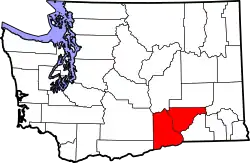Tri-Cities metropolitan area
The Kennewick–Pasco–Richland metropolitan area—colloquially referred to as the Tri-Cities metropolitan area, and officially known as the Kennewick–Richland, WA Metropolitan Statistical Area—is an metropolitan area consisting of Benton and Franklin counties in Washington state, anchored by the cities of Kennewick, Pasco, and Richland (the Tri-Cities). As of April 1, 2017, the Washington State Office of Financial Management, Forecasting Division estimates the population of the metropolitan area to be 283,830,[1] making it the third-largest metropolitan area located entirely in Washington, after the Seattle metropolitan area and the Spokane metropolitan area. Although it is located outside of the metropolitan area, the CDP of Burbank (located in Walla Walla County) is part of the Tri-Cities urban area.[2]
Tri-Cities Metropolitan Area | |
|---|---|
| Kennewick–Richland, WA Metropolitan Statistical Area | |
 Location of the Tri-Cities MSA in Washington | |
| Country | United States |
| State(s) | Washington |
| Largest city | Kennewick (80,280) |
| Other cities | - Pasco (71,680) - Richland (54,150) - West Richland (14,660) - Prosser (5,965) - Connell (5,450) - Benton City (3,360) - Mesa (488) - Kahlotus (190) |
| Area | |
| • Total | 2,942.5 sq mi (7,621 km2) |
| Highest elevation | 3,527 ft (1,075 m) |
| Lowest elevation | 265 ft (81 m) |
| Population | |
| • Total | 283,830 |
| • Rank | 165th in the U.S. |
| • Density | 95/sq mi (37/km2) |
Communities
10,001 to 50,000 inhabitants
5,000 inhabitants or fewer
Unincorporated places
Ghost towns
- Ainsworth
- Berrian
- Cactus
- East White Bluffs
- Gibbon
- Hanford (depopulated in March 1943)
- Horse Heaven
- Hover
- North McNary
- Wahluke
- White Bluffs (depopulated in March 1943)
- Yellepit
Demographics
| Historical population | |||
|---|---|---|---|
| Census | Pop. | %± | |
| 1910 | 13,090 | — | |
| 1920 | 16,780 | 28.2% | |
| 1930 | 17,089 | 1.8% | |
| 1940 | 18,360 | 7.4% | |
| 1950 | 64,933 | 253.7% | |
| 1960 | 85,412 | 31.5% | |
| 1970 | 93,406 | 9.4% | |
| 1980 | 144,469 | 54.7% | |
| 1990 | 150,033 | 3.9% | |
| 2000 | 191,822 | 27.9% | |
| 2010 | 253,340 | 32.1% | |
| 2016 (est.) | 283,846 | 12.0% | |
As of 2015, there were 279,116 people and 94,423 households residing within the MSA. The racial makeup of the MSA was 62% White, 31% Hispanic, 2% Asian, 1% Black, 1% Native, and 0% Islander.
The median income for a household in the MSA was $61,361. The per capita income for the MSA was $26,530.[3]
References
- "Population of Cities, Towns and Counties for Allocation of Selected State Revenues State of Washington" (PDF). Washington State Office of Financial Management. April 1, 2017. Archived from the original (PDF) on May 22, 2018.
- "Tri-Cities urban area map" (PDF). United States Census Bureau. Retrieved April 19, 2019.
- "Census Reporter". United States Census Bureau. Retrieved 2016-01-07.
